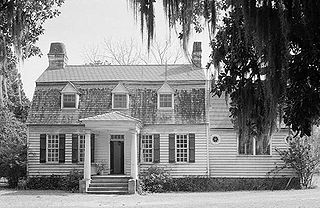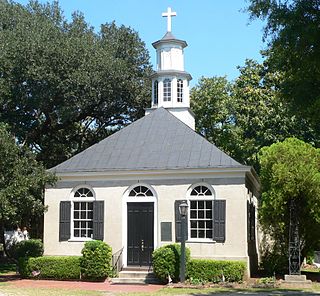
Fort Sumter is a sea fort built on an artificial island protecting Charleston, South Carolina from naval invasion. Its origin dates to the War of 1812 when the British invaded Washington by sea. It was still incomplete in 1861 when the Battle of Fort Sumter began the American Civil War. It was severely damaged during the war and left in ruins. Although there was some rebuilding, the fort, as conceived, was never completed.

Mount Pleasant is a large suburban town in Charleston County, South Carolina, United States. In the Low Country, it is the fourth largest municipality and largest town in South Carolina, and for several years was one of the state's fastest-growing areas, doubling in population between 1990 and 2000. The population was 90,801 at the 2020 census.

Sullivan's Island, historically known as O'Sullivan's Island, is a town and island in Charleston County, South Carolina, United States, at the entrance to Charleston Harbor, with a population of 1,791 at the 2010 census, and 1,891 people in 2020. The town is part of the Charleston metropolitan area, and is considered a very affluent suburb of Charleston.

Fort Moultrie is a series of fortifications on Sullivan's Island, South Carolina, built to protect the city of Charleston, South Carolina. The first fort, formerly named Fort Sullivan, built of palmetto logs, inspired the flag and nickname of South Carolina, as "The Palmetto State". The fort was renamed for the U.S. patriot commander in the Battle of Sullivan's Island, General William Moultrie. During British occupation, in 1780–1782, the fort was known as Fort Arbuthnot.
Frogmore is an unincorporated community on St. Helena Island in Beaufort County, South Carolina, United States, along U.S. Route 21.

This is a list of the National Register of Historic Places listings in Charleston County, South Carolina.

The Circular Congregational Church is a historic church building at 150 Meeting Street in Charleston, South Carolina, used by a congregation established in 1681. Its parish house, the Parish House of the Circular Congregational Church, is a highly significant Greek Revival architectural work by Robert Mills and is recognized as a U.S. National Historic Landmark.

The Oakland Plantation House which is also known as Youghall or Youghal Plantation House, was built about 1750 in Charleston County, South Carolina about 7 mi (11 km) east of Mount Pleasant. It is located about 1 mile (1.6 km) south of U.S. Route 17 on Stratton Place. It was named to the National Register of Historic Places on July 13, 1977.

Fort Fremont was a military installation on Saint Helena Island, Beaufort County, South Carolina. The fort and battery is historically significant as an example of late nineteenth and early twentieth century military architecture and as one of two surviving coastal fortifications in the United States intact from the Spanish–American War era.

Christ Episcopal Church is a church located in Mount Pleasant, South Carolina.

Fort Johnson is a state-owned historic site of military and political significance located on the northeast point of James Island in Charleston County, South Carolina.

Battery Gadsden is a historic artillery battery located at Sullivan's Island, Charleston County, South Carolina. It was built in 1903–1904, and is one of a series of batteries stretching from Fort Moultrie to the eastern end of Sullivan's Island. It was named after Christopher Gadsden. Until decommissioned in 1917, the concrete battery housed four, six inch guns. It measures approximately 377 feet long and 84 feet wide, with the front or ocean side of the battery at approximately 7 feet high. Battery Gadsden and its neighbor Battery Thomson provided fortification at the mouth of Charleston Harbor. The battery now houses the Edgar Allan Poe Branch of the Charleston County Public Library.

Battery Thomson is a historic artillery battery located at Sullivan's Island, Charleston County, South Carolina. It was built in 1906–1909, and is one of a series of batteries stretching from Fort Moultrie to the eastern end of Sullivan's Island. Until decommissioned in 1947, the concrete battery housed two, ten inch guns. It measures approximately 326 feet long and 84 feet wide, with the front or ocean side of the battery at approximately 10 feet high. Battery Thomson and its neighbor Battery Gadsden provided fortification at the mouth of Charleston Harbor.
Unnamed Battery No. 1 is an historic artillery battery located at Clark's Point, James Island, Charleston County, South Carolina. It was built in 1862, and was the southern end of the eastern James Island line. At the end of the war this battery mounted two field guns. The earthen redoubt measures approximately 240 feet long and 200 feet wide. It has a 12 foot high parapet wall and a powder magazine about 17 feet in height.
Folly North Site (38CH1213), also known as Little Folly Island, is a historic archaeological site located at Folly Beach, Charleston County, South Carolina. The site contains the extant remains of two American Civil War artillery batteries constructed by the Union Army in 1863. Artifacts associated with eight other batteries and Fort Green have likely eroded into the Atlantic Ocean. The batteries and fortifications were built as part of the Union effort to capture Charleston, South Carolina.

Battery Cheves is a historic artillery battery located at James Island, Charleston, South Carolina. It was built in 1863, and designed to protect the area between Fort Johnson and Battery Haskell. At the end of the war this battery mounted two pieces of heavy artillery. The earthen redoubt measures approximately 280 feet long and 240 feet deep. It has a 12-foot, 6 inch, high parapet wall and a powder magazine about 15 feet in height.
Battery LeRoy is a historic artillery battery located at James Island, Charleston, South Carolina. It was built in 1863, and designed to protect lower James Island. At the end of the war this battery mounted four guns. The earthen redoubt measures approximately 340 feet on its right face, 140 feet on the center face and 160 feet on the left face. It has a 15-foot-high parapet wall and a slightly higher powder magazine.
Fort Pringle is a historic artillery battery located at James Island, Charleston, South Carolina. It was built in 1863, as part of the James Island Siege Line and protect the Stono River, Johns Island and lower James Island. At the close of the war it was armed with nine heavy cannons. The earthen redoubt's river face measures approximately 360 feet, the right or upstream face 160 feet, the left or downstream face 400 feet, and the rear face approximately 520 feet in length. It has a 7.5 to 12.5 foot high parapet wall and 12.5 feet tall powder magazine.
Fort Trenholm, also known as Battery Trenholm, is a historic artillery battery located at Johns Island, Charleston, South Carolina. It was built in 1864, to reinforce Fort Pringle and protect the Stono River and Johns Island. It has emplacements for 17 guns. The three-sided earthen redoubt measures approximately 870 feet on its eastern face, 780 feet long on its southern face, and 885 feet long on its western face. It has a 15-foot-high parapet wall.
Unnamed Battery is an historic artillery battery located at West Ashley, Charleston, South Carolina. It was built in 1862, to protect the exterior western lines running from the Stono River on the south to the Ashley River at Bee's Ferry. It has emplacements for two guns. It measures approximately 160 feet by 160 feet with a 10-foot parapet and a 15-foot powder magazine.
















